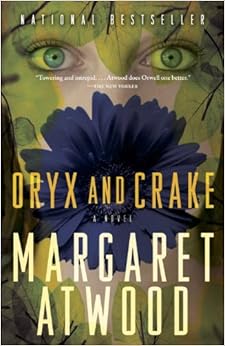“ ‘When any civilization is dust and ashes…art is all that’s
left over. Images, words, music. Imaginative structures.’ ” Snowman/Jimmy in Margaret Atwood’s Oryx and Crake
Due to PBR Book Club selections and a recent KU visit from Margaret Atwood, I’ve spent most of 2015 reading post-apocalyptic
novels, a genre I’d mostly avoided since Cormac McCarthy’s The Road, maybe because it’s so omnipresent in literature and film these days. I felt like I knew the tropes well enough. But
I found myself really moved by both Emily St John Mandel’s Station Eleven and (most of) Margaret Atwood’s Oryx and Crake, maybe because they seem
less interested in the well-worn genre details of survival in the wasteland and
more focused on the idea of how one continues to find beauty and meaning in
such a world.
Much of Mandel’s haunting novel follows a band of roving
actors continuing to perform King Lear and a few other repertory works as they move around a
world nearly decimated by a new strain of flu,
Mandel and her characters aren’t given to sweeping proclamations about the
transformative or healing powers of art. There's very little talk of what the tiny audiences may get out of the performances and, for some of the actors, their "mission" seems merely a way of maintaining a small remnant of their
past lives. Yet the book quietly speaks
to the power of art to make sense of a broken world, an idea perhaps best
represented in the volumes of a comic book called Station Eleven, whose plot parallels the characters’ plight. The
comics are carried by one of the characters and gradually revealed to link
numerous, previously disparate, characters over the course of the novel. Ultimately, though, Mandel’s book hit me
hardest not in its big-picture statements about art and humanity but in its
evocation of simple moments that might unexpectedly be your last in a civilization about to crumble or one that has already dissolved. Mandel's paragraphs expertly
bounce us in and out of past and present and future, sometimes allowing us to see looming
disaster that’s just out of sight of her characters. What’s it like to post a
silly Facebook status for the last time? What’s it like to eat what could be
the last orange on the planet? (“This orangeless world.”).
Oryx and Crake is
probably the first Atwood novel I’ve read in close to twenty years, and I was
pleased to find her still angry and often funny as hell. Still didactic too, at times, yet much of the
novel sets up an interesting and complex debate about the power of art, focused around conversations between
the characters Snowman (quoted above, rooted in a liberal arts background) and
Crake, a devotee of science who believes the world would be better off stripped
of pesky human impulses such as falling in (often unrequited) love and “making
art.” Indeed, Crake, who himself oddly becomes a “God-like” figure over the course of the
novel, creates a whole new society of creatures supposedly freed from the
trappings of art and religion. It’s certainly
clear who Atwood sides with in the bigger scheme of things, but Crake is allowed to make provocative points about his vision of a “perfect”
civilization along the way: “Their
sexuality is not a constant torment to them…They would have no need to invent
any harmful symbolisms, such as kingdom, icons, gods, or money.” Some of Crake’s philosophy might even sound
good, in theory, but Atwood suggests that the saddest and most destructive
parts of life (from failed loves to large-scale atrocities) are unavoidable
products of human nature and maybe even essential in that they produce the
greatest art, a concept embodied in perhaps the novel’s most brilliant
invention, a video game called Blood and
Roses in which players can stop humanity’s worst atrocities but only by
sacrificing the world’s greatest artistic achievements. Which will run out
first? (“It was a wicked game,” Atwood writes).
Like Mandel in Station
Eleven, Atwood ultimately allows room for hope and makes time in Oryx and Crake to focus on small human
moments where the characters can still find some temporary solace in their
permanently altered circumstances. Here, for instance,
is Snowman gazing into the distance in the final chapter of Oryx: “On the eastern horizon, there is a grayish
haze, lit now with a rosy, deadly glow. Strange how that colour still seems
tender. He gazes at it with rapture,
there is no other word for it.
Rapture…After everything that’s happened, how can the world still be so
beautiful? Because it is.”



No comments:
Post a Comment